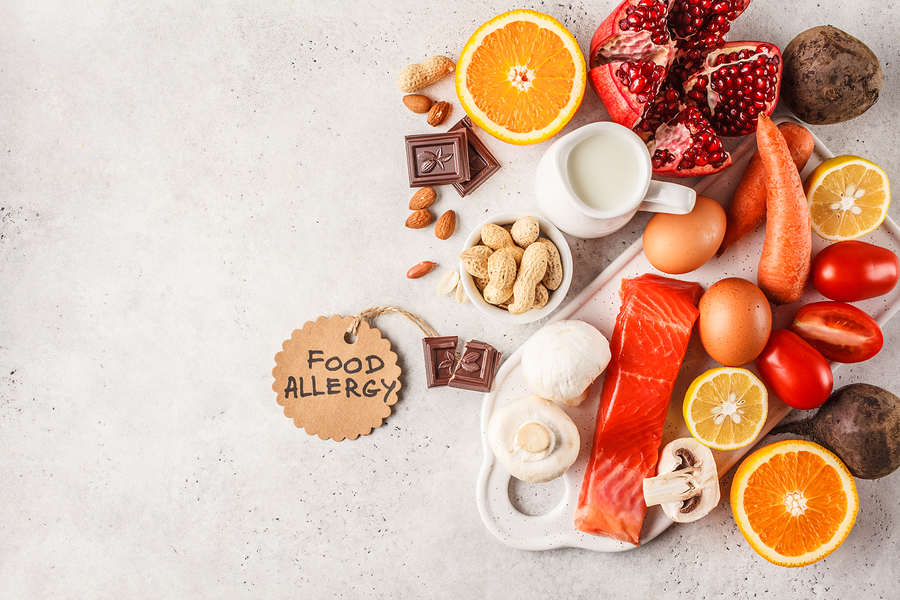Do certain foods make you ill?
With high profile, fatal cases in the news in recent months a food allergy should never be taken lightly. But how do you know if you have an allergy or intolerance?
Here we look at the difference between the two and ways to manage them.
Many of us are wary of certain foods we believe may cause us sensitivity and so are not eating them ‘just in case’ but true allergic reactions are not as common as we are lead to believe. Only as few as 2% of us Brits have a food allergy that can be medically diagnosed although as many as 30% of us ‘believe’ we have an allergy or intolerance to one or more foods.
Allergy or Intolerance?
So why is there so much confusion? Ceitanna Cooper, associate nutritionist at AXA PPP healthcare explains: “when someone with a food allergy eats a particular food their immune system produces IgE antibodies which trigger cells to release chemicals which cause an allergic response. This reaction can be medically confirmed with an allergy test.”
Symptoms can vary but for some, even eating a tiny amount of the food can cause an anaphylactic reaction which can be extremely serious and ultimately life-threatening.
“However, many people who believe they have a food allergy are actually experiencing food intolerance,” says Ceitanna Cooper. “This is when someone finds it difficult to digest certain foods and experiences symptoms such as tummy pain, intestinal gas or diarrhoea. Although these symptoms may be unpleasant they do not affect the immune system and are therefore not an allergy.”
There are only a limited amount of foods which cause allergies but foods which cause intolerances are more random and diagnosis is difficult as reactions to these foods may not be consistent each time.
“Intolerance can be caused by various things,” says Ceitanna, “it can vary from a lack of enzymes needed to digest certain foods to an oversensitivity to certain additives or preservatives found in such foods as mature cheese, yeast extract or certain wines.”
Coeliac disease – neither an allergy nor intolerance
Coeliac disease, however, is different. It is an immune reaction, unique and complex which can trigger symptoms when a coeliac eats gluten. Gluten is a protein found in pasta, bread, biscuits and oats and when consumed by someone affected by coeliac disease will damage the surface of the gut so inhibiting the absorption of certain nutrients.
Ceitanna tells us that people confuse sensitivity to wheat products with coeliac disease and then banish gluten completely from their diets. This is not a move to make lightly as gluten contains beneficial nutrients such as fibre, iron and folate which the body really needs. Eliminating gluten is not recommended without having undertaken medical tests first.
Foods to avoid
Here are 10 of the most common foods to which you are most likely to get an allergic reaction:
- Peanuts
- Soya
- Egg
- Milk
- Fish
- Wheat
- Shellfish
- Fruit
- Vegetables – such as potatoes, carrots and parsnip
- Tree nuts – such as almonds, brazils, hazelnuts, cashews, macadamia, pecan, pine nuts, pistachios and walnuts
Who is most at risk?
Children under the age of 5 are most at risk of developing allergies but these usually disappear before adulthood. However, those with peanut allergies tend to persist and some allergies can appear for the first time in adults.
There is still much research to be done as it is not yet understood why adults can start to develop allergies but doctors believe that those with a family history of other allergies, asthma, eczema or hayfever may be more at risk.
Diagnosis
As we can be allergic or intolerant to several foods at the same time it can prove hard to determine exactly which foods are the culprits. There may also be a delay between eating the food and the reaction so this can complicate matters.
A food diary of everything you eat and any symptoms that may result is a useful first tool in working out any pattern.
If you suspect an allergy then your GP can refer you for tests which may include:
- Blood tests – these will establish the amount of IgE antibodies present in your blood
- Skin prick tests – this is where a tiny amount of the food you think you are allergic to is placed on your skin and pricked to see if there is any resulting swelling, itching or burning
- Eating and watching – undertaken under medical supervision you are given a small amount of the food to eat to which you believe you are allergic and you are monitored closely for any resulting symptoms
Your GP may also ask you to follow an elimination diet where certain foods are left out for a period of time before gradually re-introducing them.
Ceitanna says “it’s important to pick only one food at a time to leave out of your diet as you may become deficient in important nutrients, so you must follow your doctor’s instructions carefully to ensure you are getting all the nutrients you need.”
“You may discover that after leaving out certain foods for a certain amount of time you are better able to tolerate small amounts of those foods. It is all a question of trial and error.”
Read the labels
It is law for manufacturers to clearly label all pre-packed foods and drinks if they contain the following 14 ingredients so it is important to carefully read the labels:
- Celery
- Cereals containing gluten
- Eggs
- Fish
- Lupin
- Milk
- Molluscs
- Mustard
- Tree nuts
- Peanuts
- Sesame seeds
- Soybeans
- Sulphur dioxide
- Sulphites
Symptoms to watch out for
You could have a food intolerance if you experience any of the following symptoms hours or days after eating a particular food:
- Nervousness, tremors, sweating, palpitations, rapid breathing or breathing problems
- Headache or migraine
- Upset tummy, stomach cramps, bloating, diarrhoea or constipation
- Skin problems or burning sensations on the skin
- Tightness across face and chest
- Tiredness
- Aches and pains
- Asthma
- Rashes
- Restless legs
- Nausea
You could have a food allergy if you experience any of these symptoms immediately or shortly after eating a particular food:
- Tingling, burning or swelling of the lips, mouth, face or throat
- Hoarseness of the throat
- Itchy, blotchy rash
- Difficulty breathing
- Wheezing
- Nausea or vomiting
- Tummy pain
- Diarrhoea
- Dizziness or light-headedness
- Red, irritated eyes
- Cold-like symptoms
- Coughing
- Tightness across the chest
You could have coeliac disease if you experience any of the following after eating wheat, rye or oats:
- Diarrhoea
- Abdominal cramps
- Recurrent mouth sores
- Skin rashes
It is recommended that you make an appointment with your GP if you experience any unusual symptoms after eating food as they will have your full medical history and are best placed to advise on the best course of action for you.
Read more on energy boosting foods and 8 ways to enrich your salads.
Disclaimer
All content on Silversurfers.com is provided for general information only, and should not be treated at all as a substitute for the medical advice of your own doctor or any other health care professional. Silversurfers will not be responsible or liable for any diagnosis made by a user based on the content on www.silversurfers.com and we are also not liable for the content of any external websites or links from or to Silversurfers to any other websites. Please always consult your own doctor if you’re in any way concerned about any aspect of your health
Melina - Assistant Editor
Latest posts by Melina - Assistant Editor (see all)
- Banana bread with SunGold kiwis - February 20, 2025
- A tribute to Bob Marley - February 4, 2025
- Going to Work on an Egg! - January 29, 2025
- The Very Best of Petula Clark - January 14, 2025
- 50 Years of Coat Trends - January 12, 2025




















